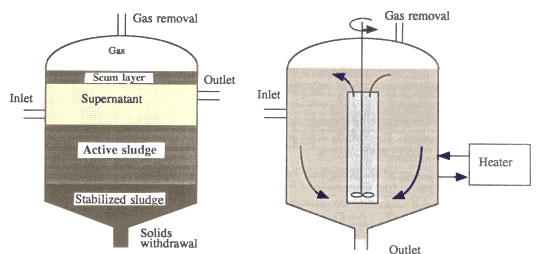6.1
Sludge Transportation to Treatment Facilities
6.2 Sludge Digestion
6.3 Land Disposal of
Sludges
6.4 Sludge Disinfection
The sludge generated in the primary and secondary treatments is a suspension of solids in concentrations ranging from about 1 to 10%, depending on the treatment from where it originates. It contains almost all of the organic load removed from the treated wastewater. Although it is in a different form, it is organic matter that may eventually decompose, be offensive and be a contaminant if not treated properly.
In this section, only the most simple treatments will be discussed. 'Me description of more elaborate processes such as chemical conditioning, heat treatment, machine-drying and thermal reduction or incineration can be found elsewhere (Metcalf and Eddy Inc., 1979; Eckenfelder, 1980). Some of the treatments described here may be applicable only by fisheries which have large processing capacities (e.g., digestion), while others (hauling) are more appropriate for smallscale, intermittent operating plants.
The transportation of the sludge generated in plants to sludge treatment facilities is conceptually simple. Since the sludges from fish processing plants are highly biodegradable they will probably be accepted without problems. For small fish processors this solution may only be adopted due to the lack of space for sludge treatment. Other advantages are that no investment is needed for the treatment units and the only operating costs are those of transportation and the fees charged by the remote sludge treatment facility.
Sludges are residues with relatively high carbon content and are good candidates for anaerobic digestion as they are wastes with high organic content. The digesters are very similar to those of anaerobic treatment of wastewaters described previously in section 4. Here, the cells produced by the anaerobic treatment undergo hydrolysis and enter the process depicted in Figure 4.14. For sludge digestion, two processes are the most common: the conventional digestion and the high rate digestion, as shown in Figure 6.1.

Figure 6.1. Conventional (left) and high rate (right) sludge digestion processes
In the conventional digestion process, sludge digestion and sludge thickening are carried out in the same vessel. The sludge enters the digester in the zone where active digestion is taking place. Due to the conversion of biomass to gases, the sludge stabilizes and settles to the bottom. The gas formed accumulates in the upper part of the digester and, while it rises, carries small particles of oil/grease which form a scum layer on top. Here, the goal is to stabilize the sludge, converting most of it into gas. Typical retention times range from 30 to 60 days and the contents are normally heated to near 35°C in order to accelerate the anaerobic reactions which otherwise would require much more time.
In the high rate sludge digestion, the sludge is mixed by recirculating the gas formed in a draft tube or by pumping. Typical power consumption for mixing ranges from 0.006 to 0.01 kW/m3. Retention times in the digester are shorter (10-20 days) than in the conventional process and higher organic loads can be used. Due to continuous mixing, this process requires a settling tank after the digestion stage.
This is one of the lower cost alternatives for final sludge disposal. It is practised for two reasons: the need to dispose of the sludge (itself also a residue) and the opportunity to use the contents (organic matter, nitrogen and phosphorus) as fertilizer. Sludge land application has proven to be a viable substitute for commercial fertilizer, provided pathogenic control is applied.
Site selection is an important factor; it should be relatively far from waterbodies and the soil should be moderately permeable and well-drained, with a maximum slope of 5-8% in order to minimize erosion problems during application. Neutral to alkaline soils are preferred to reduce heavy metal mobility, the concentration of which should also be periodically checked.
The application of the sludges on the soil can be carried out by spreading from tank trucks or by sprinkling. Trenching or ploughing mixes the soil and sludges adequately, reduces odour and run-off.
The disinfection of sludges is especially important before they are applied to the land because of possible existence of pathogenic micro-organisms.
One of the simplest forms of disinfection is the addition of chlorine to stabilize and disinfect the sludge. The chlorine for disinfection dosage varies between 2 mg/l and 15 mg/l, depending on the solids content. It is usually done in tanks provided with good mixing capability. Retention times range from 15 to 45 minutes.
The storage of sludge for long-term is another low-cost practice, applicable only if enough land is available. The storage time for pathogen reduction depends on temperature: 60 days is recommended if the average temperature is 20°C or 120 days if it is only 4°C.